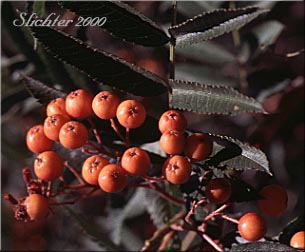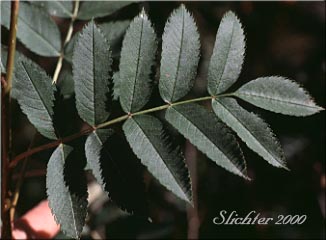 The
photo at right shows the orange fruits of Cascade mt. ash as seen from east of
Monument Rock Wilderness, Malheur N.F......... September 6, 1999.
The
photo at right shows the orange fruits of Cascade mt. ash as seen from east of
Monument Rock Wilderness, Malheur N.F......... September 6, 1999.
Cascade mountain ash is also known as western or Greene's mountain ash. It is an erect, several-stemmed deciduous shrub or small tree from 1-4 meters in height. The twigs are round, 2-4 mm in diameter and brown in coloration, with wrinkled and slightly short hairy surfaces that have vertical, white or orange raised areas. The winter buds are dark brown, glandular, and covered with white hairs.
The leaves are alternate on the stems. Individual leaves are pinnately compound, with 9-13 leaflets. The leaflets are narrowly oblong or oblong-elliptic to oblong-lanceolate in shape, and range from 3-7 cm long and usually less than 1/3 as wide. The leaflets are serrate margined much of their circumference. The tips of the leaflets may be acutely pointed, or more commonly blunt with a short point at the tip.
The inflorescence is a flat-topped cluster or corymb of 70-200 small white flowers. The calyx of each flower is covered with white hairs. Each of the 5 petals is oval in shape and from 5-6 mm long. The fruits are small (1 cm long) and glossy orange to scarlet in color. The fruits are found in clusters.
The fruits are an important food source for both birds and small mammals during the winter months. The western species of mountain ash have not been as extensively used for horticultural purposes as the eastern species, although Cascade mt. ash is well suited for such purposes.

Leaf of Sorbus scopulina from east of Monument Rock Wilderness, Malheur N.F.........September 6 1999.
Cascade mountain ash is found in upland woods from the foothills to subalpine or alpine slopes.
Cascade mountain ash may be found from Alaska south to northern California, and east to Alberta, the Dakotas, and New Mexico. In the Pacific Northwest, it is found on both sides of the Cascades, but is most common east of the Cascade crest.
In the Columbia River Gorge, it may be found between the elevations of 3300'-4900' from Silver Star Mt. in the west to Mt. Defiance in the east.